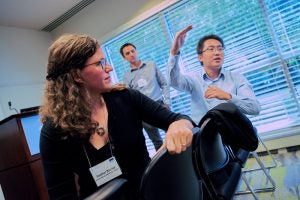

Human-environment interactions are complex. Capturing this complexity is essential to understand enteric disease transmission.
In the event entitled, “Quantifying Human Exposures for Enteric Disease Transmission” chaired by Dr. Tim Julian, I recently presented with an outstanding group of individuals at the International Water Association meeting on Health Related Water Microbiology, and the UNC Water Microbiology conference, held in Chapel Hill, NC May 15-19. The goal was to discuss how we can capture, model and assess the importance of human-environment interactions to better understand risk.


Dr. Julian introduced the historical context of exposure assessments and macro-level observational strategies. Dr. Wang presented on structured observations and the competing hazards model developed for the Sanipath project in Ghana. I presented on videography and the Microlevel Activity Time Series based on my experiences with the VUNA project in South Africa. Professor Harada presented on using biomarkers to assess indirect exposures based on work in Bangladesh. A group discussion followed.

Photos credit: The Water Institute at UNC